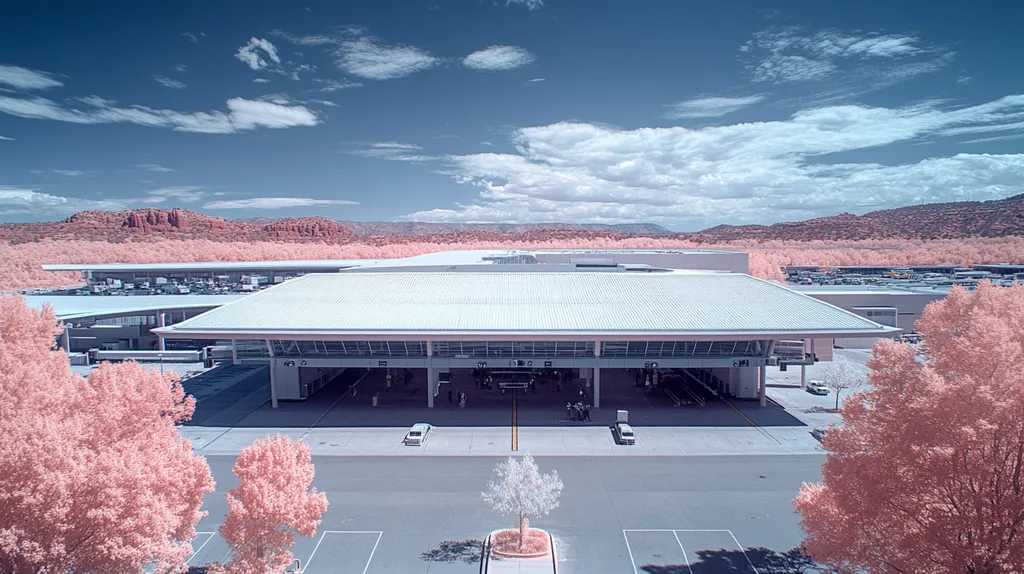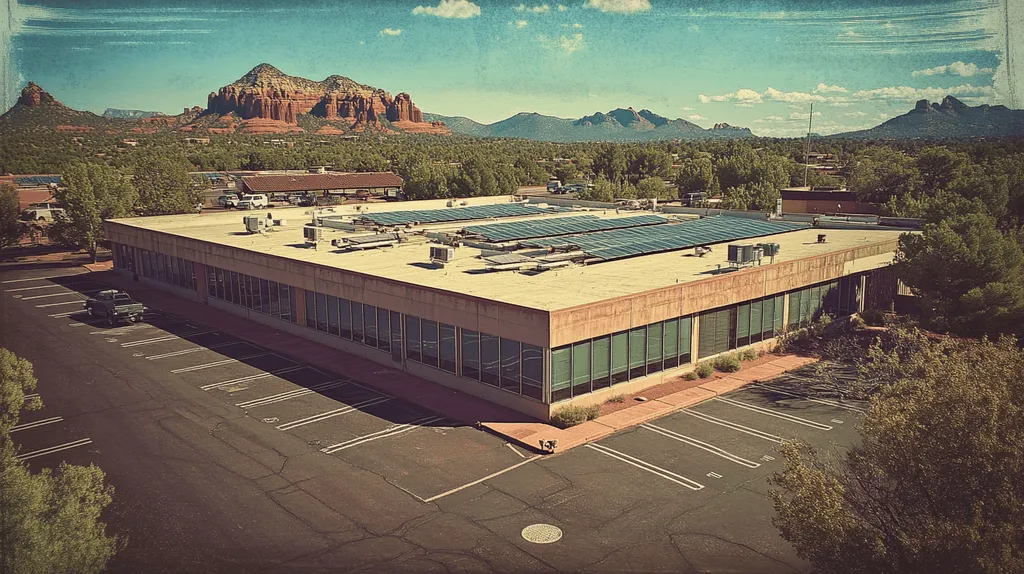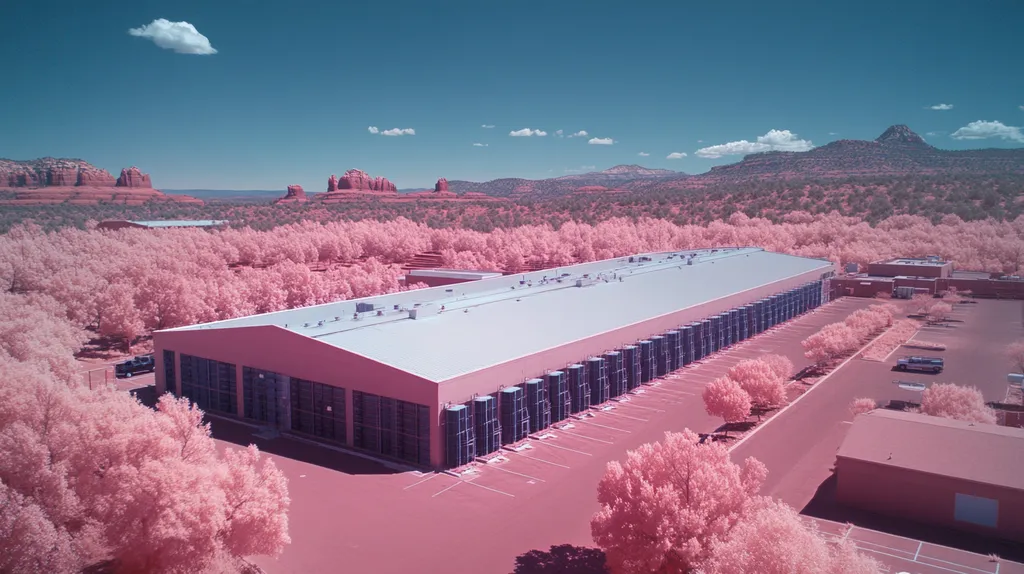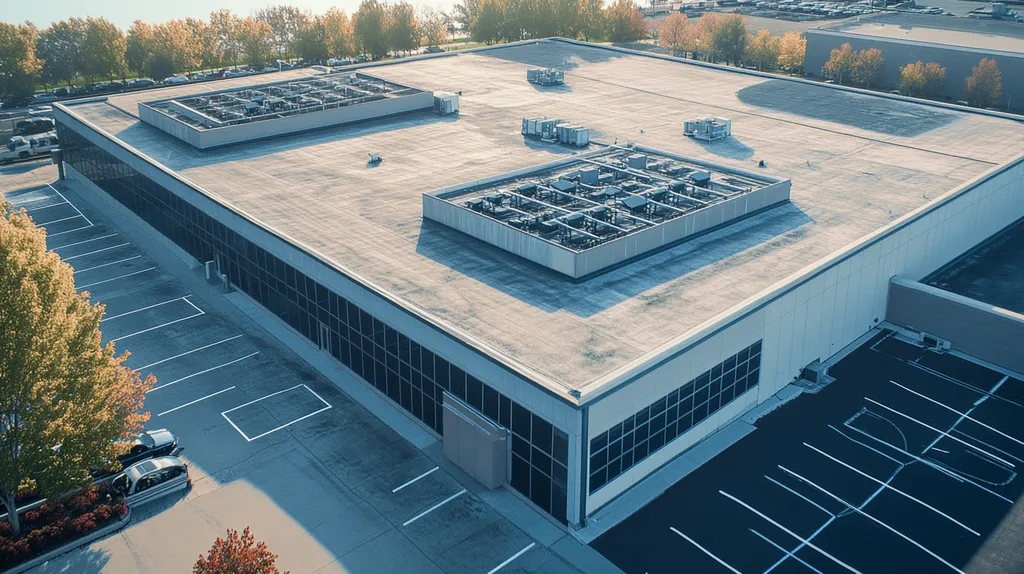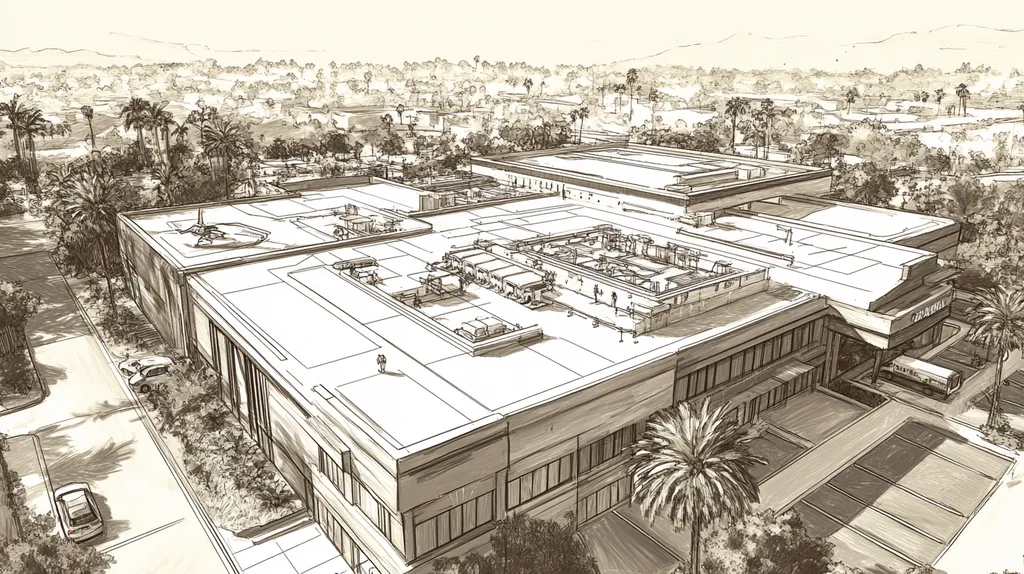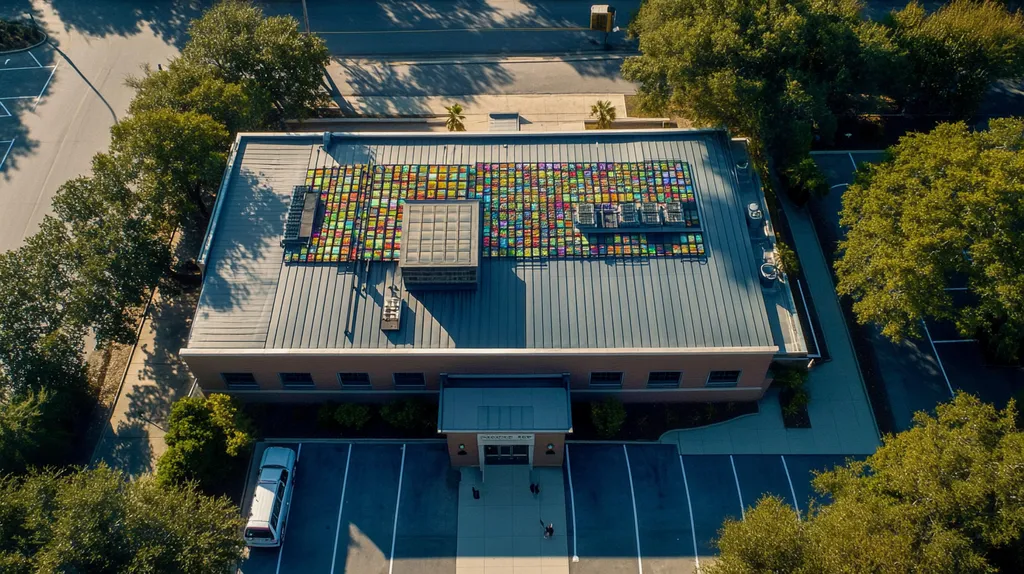Commercial roof penetrations account for over 40% of all roof leaks, costing property owners billions annually in repairs and damaged assets. Despite established maintenance protocols, traditional leak prevention strategies continue to fall short of addressing these critical vulnerabilities.
Recent industry data reveals that conventional approaches to sealing and maintaining roof penetrations are based on outdated assumptions that fail to account for modern building systems and changing weather patterns.
This analysis challenges long-held industry practices, examining systemic flaws in current methods while presenting evidence-based alternatives that promise superior protection for commercial properties.
SECTION 1: CURRENT PRACTICES
Commercial roof penetrations are often the weak links that lead to leaks, which can cause severe financial losses and disrupt daily operations. Alarmingly, research indicates that more than 50% of roof problems originate from insufficient sealing and maintenance around these points. Without addressing these vulnerabilities, property owners expose themselves to potential hazards such as significant structural damage and expensive repair bills. This section examines the prevalent practices in inspection, sealing, and maintenance, revealing their shortcomings in effectively preventing leaks.
Routine Inspection Schedules
Routine inspection schedules are often thought of as the frontline defense against roof leaks. Yet, many of these inspections lack the thoroughness needed to catch critical signs of deterioration. For instance, visual checks may miss the subtle degradation of sealants around high-risk areas like HVAC units and vent pipes.
Typically, property managers opt for annual inspections, which may not suffice, particularly in regions prone to severe weather. These inspections can turn into mere formalities, addressing visible issues while overlooking underlying threats. This oversight can allow damage to accumulate, leading to costly leaks over time.
Moreover, depending only on scheduled inspections fosters a reactive maintenance culture. As roofs age, they often require more frequent evaluations to maintain their integrity. Transitioning to a more proactive inspection strategy could drastically lower the risk of premature failure.
In summary, while routine inspections are important, their limitations render them an inadequate stand-alone solution for minimizing leaks at roof penetrations. A comprehensive maintenance strategy must supplement inspection practices to effectively ensure roof integrity.
Standard Sealing and Flashing Methods
Standard sealing and flashing methods are widely used to safeguard roof penetrations. However, many techniques are outdated, failing to utilize modern materials and technologies. Traditional caulking may weaken over time, creating pathways for water intrusion.
Innovative sealants and flashing systems provide enhanced protection, yet many facilities continue to rely on standard methods that do not evolve with roofing advancements. This reliance only increases vulnerability to leaks.
Additionally, installation practices can vary significantly among contractors, leading to inconsistent performance. A poorly installed flashing system can result in pooling water, causing leaks regardless of the materials used. This variability complicates decision-making for property owners.
In conclusion, while sealing and flashing are essential for leak prevention, current practices often fall short due to outdated techniques and inconsistent application. By embracing innovation and proper training, property owners can achieve better results in maintaining roof integrity. Proper detailing around roof penetrations is critical for long-term leak prevention (source: AQUILA Commercial).
Common Maintenance Programs
Common maintenance programs typically focus on basic tasks like debris removal and visible damage inspections. Unfortunately, these programs often lack the depth necessary for comprehensive leak prevention. For instance, merely cleaning gutters does not address underlying concerns such as deteriorating sealants or unsealed penetrations.
Many maintenance programs overlook specific challenges presented by roof penetrations, making them less effective in mitigating serious risks. It is not uncommon for these routines to neglect critical assessments in less visible areas, such as behind rooftop equipment, where leaks commonly occur.
Furthermore, these programs often do not prioritize equipping staff with the knowledge to identify potential leak precursors. Without this training, maintenance personnel may overlook important warning signs that could help prevent substantial water damage.
In summary, while common maintenance programs aim to promote roof longevity, their limited focus can leave facilities vulnerable to preventable leaks. A targeted strategy that addresses the unique challenges of roof penetrations could greatly enhance their effectiveness.
SECTION 2: SYSTEMIC ISSUES
Leak prevention strategies for commercial roof penetrations frequently fall short due to systemic issues prevalent in the roofing industry. A 2021 study revealed that roofs with inadequate drainage systems are 40% more likely to develop leaks compared to those with properly designed drainage. The neglect of critical factors like installation practices and the effects of seasonal weather can lead to costly repairs and even untimely roof failures. This section spotlights the structural deficiencies that jeopardize roof integrity, advocating for a thorough re-examination of current practices.
Inadequate Drainage Systems
The effectiveness of drainage systems is essential for preventing roof leaks. Insufficient drainage allows water to accumulate, creating an environment ripe for leaks to form. Research indicates that roofs with poorly designed drainage systems experience water pooling, which increases pressure on seams and penetrations.
This prolonged pressure contributes to the deterioration of roofing materials, setting off a cycle of damage. Moreover, inadequate drainage fails to address seasonal weather challenges, such as ice and snow buildup. A well-designed drainage system must effectively manage both rain and winter conditions to maintain a leak-proof roof.
Property owners should conduct regular evaluations of their drainage systems to ensure they meet the demands of their specific climates. Routine maintenance checks help identify potential issues before they escalate into significant leaks, ultimately saving money over time. Investing in superior drainage solutions is not just a necessity; it’s a strategic move for long-term roof health.
Poor Initial Installation Practices
The initial quality of roof installation significantly impacts the long-term performance of commercial roofing systems. Reports suggest that improper installation contributes to up to 70% of roofing failures. Common errors include overlooking manufacturer specifications, using subpar materials, and neglecting proper sealing techniques around penetrations.
Inattention during installation can create problems like misaligned flashing, insufficient overlaps, and vulnerable seams. Each of these issues represents a potential entry point for water that needs to be addressed before they develop into leaks. The financial repercussions of poor installation can easily exceed any initial savings on labor and materials.
To tackle these challenges, property owners should prioritize hiring certified roofing professionals who adhere to industry standards. Comprehensive training for installation crews can dramatically minimize the risk of costly errors that result in long-term roofing problems.
Neglect of Seasonal Weather Impacts
Seasonal weather changes can profoundly affect a roof’s ability to fend off leaks. Many commercial property owners overlook how extreme temperatures, heavy rains, or snowfall can put stress on roofing systems. For instance, heavy snow can lead to the formation of ice dams, causing water to back up and seep into penetrations.
Adopting a proactive approach to seasonal maintenance is essential. Conducting roof inspections before and after significant weather events can help identify vulnerabilities that changing conditions might exacerbate. Roof membranes and sealants may require adjustments, or more robust solutions might be needed to endure harsh climates.
Additionally, understanding the local climate allows property owners to make informed choices about roofing materials and designs. This proactive strategy not only helps prevent leaks but also extends the lifespan of commercial roofs, effectively safeguarding valuable investments over the long term.
SECTION 3: MISSED OPPORTUNITIES
When it comes to commercial roofing, even small oversights can spell disaster. Minor issues, unreported employee observations, and reliance on outdated materials can compound over time, leading to costly repairs, operational disruptions, and even safety hazards. Unfortunately, property owners and facility managers often overlook these critical areas during regular maintenance, ultimately jeopardizing their roofing systems’ longevity and performance. This section highlights key missed opportunities that should be addressed to bolster roof resilience.
Overlooking Minor Issues
Minor issues, like tiny cracks or gaps around penetrations, are frequently underestimated. However, these seemingly insignificant openings can create serious water infiltration issues over time. A small crack may appear harmless, but if left unaddressed, it can compromise structural integrity, promoting mold growth and driving up energy costs.
Routine inspections often overlook these minor flaws because they may not be conducted with the necessary attention to detail. Property owners may focus on larger problems while ignoring subtle vulnerabilities that can escalate into major leaks. The cumulative effect of ignoring these minor issues can lead to substantial financial repercussions as repairs become inevitable.
By adopting a proactive maintenance approach that prioritizes small repairs, facility managers can significantly reduce water intrusion and associated costs. Conducting regular, thorough inspections enables the early identification of these issues, which in turn protects the roof’s lifespan and functionality.
Treating minor issues with urgency is essential for safeguarding the building’s integrity and enhancing overall property value, ultimately resulting in increased tenant satisfaction.
Ignoring Employee Reporting
Employees within facilities are often the first to notice signs of roof leakage, yet their observations can go unreported, allowing issues to worsen. Ignoring these early warning signs can lead to missed opportunities for timely intervention, resulting in costly repairs and interruptions to daily operations.
Encouraging open communication between staff and facilities management can vastly improve leak detection efforts. Establishing click-to-report systems or regular communication channels empowers employees to quickly share any concerns they observe. This proactive approach minimizes the impact of leaks, ensuring smoother business operations.
Facilities managers should foster a culture of vigilance where everyone is encouraged to be proactive regarding potential roofing issues. Providing training on what to look for can enhance the accuracy and urgency of reports, helping to prevent severe roof damage before it occurs.
Engaging employees in the reporting process not only leverages invaluable first-hand insights but is also critical for building a robust leak prevention strategy.
Lack of Material Upgrades
Evaluating the long-term effectiveness of roofing materials is vital for maintaining roof integrity. Many commercial roofing systems still rely on outdated materials that lack durability and cutting-edge waterproofing properties. As technology advances, new materials offer superior resistance to environmental stressors and longer-lasting performance.
Neglecting to upgrade materials can precipitate faster wear and tear, creating ample opportunities for leaks to develop. Although budget constraints may deter investment in modern materials, the long-term return on investment often far outweighs the initial costs associated with these improvements.
Property owners should incorporate routine material evaluations and upgrades as essential components of their roofing maintenance plans. By investing in superior materials, organizations can significantly enhance performance and reduce maintenance costs, ultimately benefiting their finances.
These upgraded solutions often come with warranties, providing peace of mind for property owners. Investing in advanced roofing materials not only minimizes leaks but also extends the overall lifespan of the roof itself.
SECTION 4: ROOT CAUSES
Leaks from roof penetrations create urgent challenges for commercial properties, resulting in costly repairs and potential damage to valuable assets like inventory and equipment. Alarmingly, studies reveal that a staggering 80% of commercial roof leaks arise from improper sealing around penetrations. Pinpointing root causes is crucial for implementing effective leak prevention strategies. This section delves into three primary issues: weather-induced material degradation, structural deficiencies, and ineffective sealing practices.
Weather-Induced Material Degradation
Weather conditions are relentless adversaries for roofing materials, especially around penetrations. Extreme temperatures, heavy rainfall, and strong winds can significantly accelerate the deterioration of seals. For example, prolonged UV exposure can break down roofing membranes, jeopardizing the strength of seals.
As these seals weaken, moisture can easily infiltrate through penetrations, leading to extensive damage to both the roof itself and the interior spaces below. Unfortunately, many property owners underestimate how much the environment can impact their roofs, heightening their risk of leaks.
To combat this, regular maintenance is essential. Property managers should conduct thorough inspections, especially after severe weather, to catch signs of degradation. By acknowledging how weather affects roofing materials, facility managers can devise strategic maintenance schedules that significantly curb leaks.
Furthermore, selecting high-quality materials designed to endure local climate challenges enhances roof resilience. A proactive approach ensures that properties are well-equipped to withstand the harsh realities of changing weather patterns.
Structural and Design Deficiencies
Structural weaknesses can critically undermine the integrity of commercial roofs, particularly at penetration points. Design flaws, such as inadequate drainage systems or insufficient slope, can lead to problematic water pooling. This pooling not only increases pressure on seals and membranes but can also accelerate their deterioration.
For instance, flat roofs without proper drainage are particularly susceptible to leak issues. It’s vital for roof designs to facilitate effective water management, utilizing proper slopes to redirect water away from high-risk areas.
Additionally, existing structural components might not provide adequate support for roof penetrations. If ducts or pipes are not properly secured, they can shift over time, compromising seals and inviting water infiltration. Conducting routine structural audits helps identify these vulnerabilities before they escalate.
Resolving structural and design deficiencies hinges on collaboration among architects, engineers, and roofing contractors. By prioritizing structural integrity during roof design, property owners can significantly reduce the risks associated with penetrations.
Ineffective Penetration Sealing
Ineffective sealing practices are a primary source of leaks in commercial roofing systems. Standard sealing materials may lack the necessary durability or flexibility needed for penetration protection. Many property owners unknowingly choose subpar sealants that fail rapidly under harsh conditions.
For instance, low-quality caulk can lose effectiveness within just a few years when subjected to the elements. This vulnerability can lead to leaks and ultimately drive up maintenance costs. Understanding the differences in sealant quality allows property owners to make informed choices that enhance leak prevention.
Moreover, improper application is a common pitfall for creating effective seals. Failing to prepare surfaces adequately or applying insufficient coverage can leave critical vulnerabilities. Engaging professionals trained in proper sealing techniques is crucial for creating robust barriers against moisture infiltration.
Investing in high-quality materials and skilled labor during installation proves invaluable in preventing leaks. Additionally, providing comprehensive training for maintenance staff on the nuances of sealant application amplifies overall roof performance and minimizes leak risks.
DATA DRIVEN EVIDENCE
Commercial roof penetrations present significant risks, leading to expensive leaks that can disrupt operations and drain budgets. Strikingly, studies indicate that over 70% of leak-related repairs are attributed to these vulnerabilities. Property owners must grasp the urgency of implementing more effective strategies to address these risks. A deep understanding of repair frequencies, the financial advantages of preventative maintenance, and the interaction between climate and roofing materials is essential for sound decision-making.
Frequency of Leak-Related Repairs
Data surrounding leak-related repairs reveals an alarming trend for facility managers. Around 60% of building owners encounter leaks from roof penetrations at least once per year. These recurring repairs not only disrupt daily operations but also divert funds that could otherwise be used for essential maintenance activities.
Additionally, the time spent managing these leaks detracts from strategic planning and more proactive maintenance efforts. Areas like vents, drains, and HVAC units are particularly vulnerable when not properly sealed, highlighting a critical need for a shift towards prevention rather than reaction.
By closely monitoring repair frequencies, property owners can uncover substantial savings associated with better sealing strategies. Adopting a proactive stance on maintenance can significantly lower leak occurrences, ultimately benefiting both financial stability and operational efficiency.
Cost Analysis of Preventative Maintenance
The financial ramifications of neglecting preventative maintenance for roof penetrations are staggering. Research has shown that for every dollar invested in preventive measures, property owners can save up to four dollars in reactive repairs. This compelling cost-benefit ratio underlines the importance of investing in robust sealing techniques.
Preventative maintenance not only reduces repair expenses but also extends the lifespan of roofing systems. This is particularly crucial in commercial contexts, where roof replacements can cost tens of thousands of dollars. Ignoring these proactive measures can lead to premature roof failures and mounting expenses over time.
Moreover, incorporating innovative sealing technologies can result in significant returns. For example, using liquid-applied membranes or advanced flashing systems can more effectively minimize risks than conventional approaches. These investments can shift roofing budgets from a reactive burden to an optimized expense that protects property value.
Impact of Climate on Roofing Materials
Climate plays a critical role in determining the performance and longevity of roofing materials, especially around penetrations. In regions experiencing extreme weather, traditional roofing systems may struggle without adequate reinforcement. Studies indicate that roofs in areas with drastic temperature variations are 50% more likely to fail due to the stresses of thermal expansion and contraction.
Additionally, moisture and precipitation levels heavily influence the integrity of roof penetrations. Many roofing applications cannot maintain their effectiveness in persistently wet conditions, amplifying the potential for leaks. A thorough understanding of local climate patterns is essential for selecting appropriate materials and techniques.
Ultimately, choosing roofing systems designed to endure local environmental conditions significantly enhances leak prevention. Facility managers must adopt a tailored approach by integrating climate data into their material and sealing method selections. This informed strategy can drastically reduce the risks associated with roof penetrations and enhance overall roof resilience.
SECTION 6: ALTERNATIVE SOLUTIONS
As commercial property owners tackle the relentless challenge of roof leaks, traditional methods for managing penetrations are increasingly inadequate. Alarmingly, nearly 60% of commercial roof leaks stem from these critical areas. This statistic highlights the urgent need for innovative strategies that provide robust solutions beyond what conventional practices offer. The following sections delve into advanced inspection technologies, the selection of high-performance materials, and comprehensive maintenance plans that can effectively diminish the risk of leaks.
Advanced Inspection Technologies
Advanced inspection technologies are transforming how commercial roofs are examined and maintained. Traditional visual inspections often overlook hidden problems, leaving property owners unprotected. Innovative methods like thermal imaging and drone surveillance provide a holistic view of rooftop conditions and pinpoint potential leak sources.
For example, thermal imaging can reveal temperature discrepancies that indicate insulation or moisture issues around penetrations. Drones effortlessly access hard-to-reach areas, enabling thorough inspections without risking worker safety. These forward-thinking technologies allow for proactive maintenance, addressing issues before they spiral into costly repairs.
Data analytics further enhances inspection effectiveness. Predictive algorithms leverage historical roofing performance data to optimize inspection scheduling based on known vulnerabilities. This strategic foresight not only reduces the frequency of leaks but also prolongs the life of the roofing system.
By investing in these advanced technologies, property managers can make informed repair and maintenance decisions. Transitioning from reactive to proactive strategies empowers building owners to protect their investments while improving overall operational efficiency.
High-Performance Material Selection
Choosing high-performance materials is essential for mitigating leaks at roof penetrations. Many conventional roofing materials lack the durability needed to withstand extreme weather, increasing vulnerability over time. Innovative materials, such as silicone and polymer-modified bitumen, deliver superior protection and sealing performance.
Silicone coatings offer exceptional waterproofing abilities and UV resistance, making them ideal for safeguarding vulnerable areas. Meanwhile, polymer-modified bitumen’s elasticity accommodates building movement without compromising integrity. These advanced materials help ensure that penetrations maintain a watertight seal for years.
Integrating redundant systems can also boost protection. Although these materials may entail higher upfront costs, they lead to significant long-term savings by minimizing maintenance and repair needs. Strategic material selection is a fundamental aspect of an effective leak prevention strategy.
Property owners must prioritize material choice within their overall roofing strategy. A commitment to high-performance materials not only enhances proactive leak prevention but also reduces repair costs should issues arise.
Comprehensive Preventative Maintenance Plans
A comprehensive preventative maintenance plan is vital for reducing leaks from commercial roof penetrations. Scheduled inspections and maintenance are proven strategies for identifying early signs of deterioration. Establishing a routine maintenance schedule can significantly diminish the risk of unexpected roof failures.
Effective maintenance plans should include regular cleaning around penetrations to prevent water pooling and debris accumulation. Routine checks on flashing, seals, and cants are crucial for catching wear and tear before they lead to leaks. Documenting these inspections allows facilities managers to track conditions over time and adjust strategies as required.
Moreover, collaborating with a trusted roofing contractor to craft a customized maintenance strategy can enhance overall effectiveness. These professionals can provide valuable insights into building-specific vulnerabilities, promoting a targeted approach rather than a one-size-fits-all solution.
Implementing a thorough maintenance plan not only lowers the incidence of leaks but also extends the life of the roofing system. Property owners who prioritize planned maintenance can expect reduced costs and improved operational efficiency long-term.
The Bottom Line
With over 40% of commercial roof leaks originating from penetrations and annual repair costs exceeding $3.3 billion industry-wide, the need for revolutionary approaches to leak prevention is critical.
Traditional strategies have proven inadequate against modern building demands and increasingly extreme weather patterns.
The evidence demonstrates that successful leak prevention requires a three-pronged approach: implementation of advanced inspection technologies, adoption of high-performance materials, and development of data-driven maintenance protocols.
Property owners who fail to evolve beyond conventional practices face escalating repair costs, accelerated roof deterioration, and increased risk of catastrophic failure.
The future of commercial roofing demands immediate action to address these vulnerabilities through systematic modernization of penetration protection strategies.
FREQUENTLY ASKED QUESTIONS
Q. What are common practices for sealing commercial roof penetrations?
A. Common practices include routine inspections and standard sealing methods. However, these often fall short due to outdated techniques and inconsistent application. Without adopting advanced sealing materials and proactive strategies, property owners leave their roofs vulnerable to leaks.
Q. How do systemic issues affect leaks in industrial roofs?
A. Systemic issues such as inadequate drainage and poor installation practices contribute significantly to leaks. Neglecting critical installation factors increases the likelihood of water pooling, which exacerbates leak risks, particularly during severe weather. A systematic reassessment of these practices is essential.
Q. What minor issues are often overlooked on commercial roofs?
A. Minor issues like small cracks around penetrations are frequently underestimated. These insignificant flaws can develop into substantial leaks over time if ignored. A proactive maintenance approach prioritizing small repairs can significantly minimize water intrusion and associated costs.
Q. How does weather affect commercial roof performance?
A. Weather conditions can drastically impact the performance of roofing materials. Extreme temperatures, heavy rains, and snow contribute to material degradation, particularly around penetrations. Regular inspections and understanding local climate patterns can enhance roof resilience and minimize leaks.
Q. What evidence suggests the necessity of preventative maintenance?
A. Evidence indicates that neglecting preventative maintenance results in increased repair costs, with studies showing significant savings associated with proactive strategies. By investing in regular inspections and maintenance, property owners can greatly reduce the frequency and severity of leaks.
Q. What alternative solutions are available for minimizing leaks?
A. Alternative solutions include advanced inspection technologies and high-performance materials. Utilizing thermal imaging and drones can reveal hidden issues, while selecting durable materials enhances sealing effectiveness. Comprehensive maintenance plans further reduce the risk of leaks and promote longevity.
Q. How can I improve communication about roof issues in my facility?
A. Establishing open communication channels with staff is crucial for leak detection. Implementing click-to-report systems can empower employees to report observations promptly. Training staff to recognize early signs of roof issues ensures timely interventions, minimizing potential damage and disruptions.

